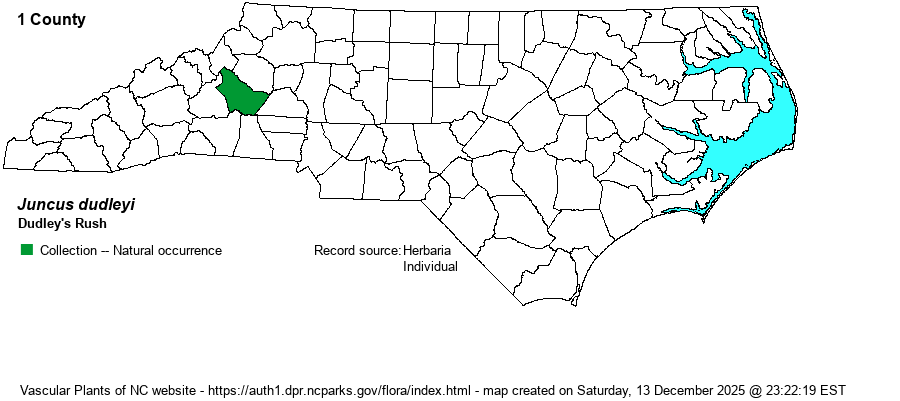| Author | Wiegand | |
| Distribution | The only credible records in NC for this species of calcareous and circumneutral soils are from Linville River in Burke County, discovered by Tom Govus in 2005 (pers. com. to Weakley). A voucher specimen from Linville River at herbarium APSC appears to be J. dudleyi; it was collected in 2014 by Devin Rodgers. Specimens in SERNEC from Bladen and Harnett counties in the Coastal Plain are from "abandoned field" and "roadside ditch", and are misidentified.
Lab. to AK, south to SC, AL, TX, CA; Mex. However, the species is very rare south of VA in the Atlantic and Gulf states. | |
| Abundance | Though recorded from numerous counties in VA, including most Mountain ones and scattered ones in the Piedmont and Coastal Plain, the southern edge of the range practically stops there, as it is -- as far as known -- extremely rare in NC, with one valid record. However, it ought to be eventually found in the northern Mountains. This is a Significantly Rare species. | |
| Habitat | The habitat data for NC is montane river scour zone. Weakley (2018) says "Calcareous seepages and fens, river-scours" for the Southeastern states. |
| Phenology | Flowering and fruiting June-September. | |
| Identification | Dudley's Rush is closely similar to the widespread Forked Rush (J. dichotomus), but differs in its thickish, yellowish auricle at the tip of each leaf sheath (vs. thinnish and whitish), tepals spreading in fruit (versus not), and anthers 0.6-1 mm (versus 0.4-0.6 mm). | |
| Taxonomic Comments | None
NOTE on Juncus: These "grasslike" or "sedgelike" plants occur in most habitats, especially where moist or wet. They can immediately be told from grasses and sedges by the presence of 6 tepals (petal-like) that surround the fruit. These tepals can be thought of as analogous to sepals and petals of, say, lilies or trilliums. Most species have brown, chestnut, or reddish tepals and dark brown fruits. The flowers occur in few- to many-flowered heads. Leaves are nearly all basal and round in cross-section. Stems are unbranched, except for the inflorescence. Fruits are termed capsules and contain many tiny seeds. | |
| Other Common Name(s) | None | |
| State Rank | S1 | |
| Global Rank | G5 | |
| State Status | SR-P | |
| US Status | | |
| USACE-agcp | FACW link |
| USACE-emp | FACW link |

